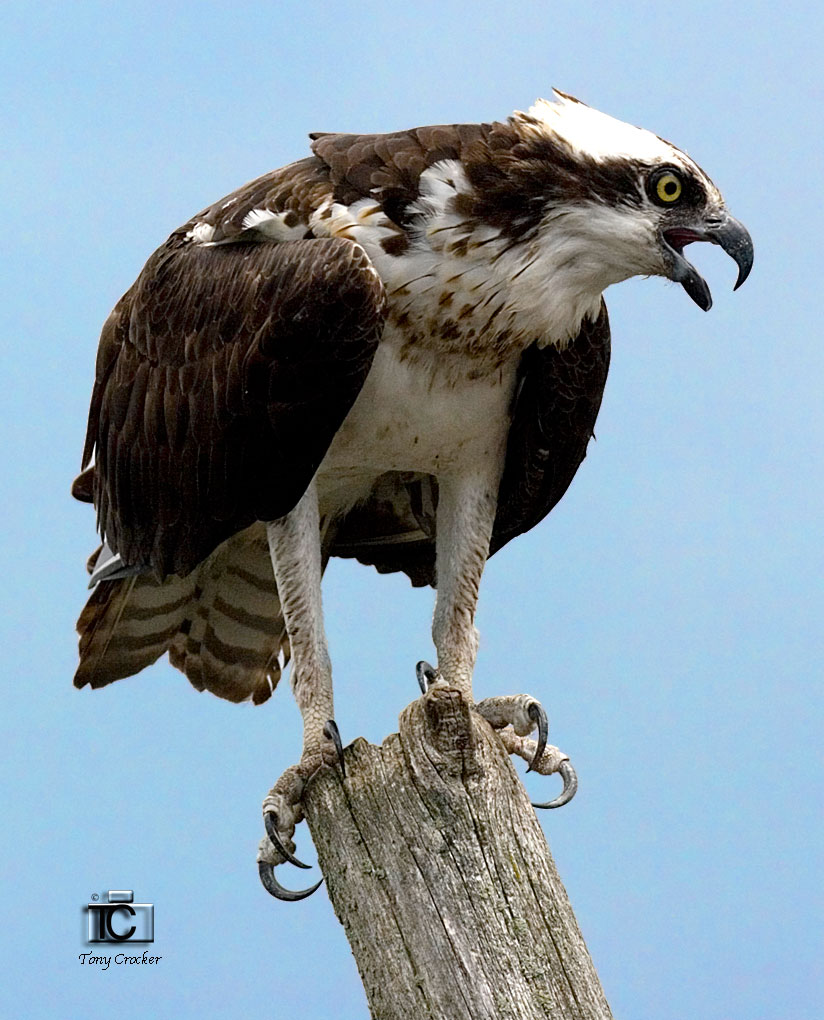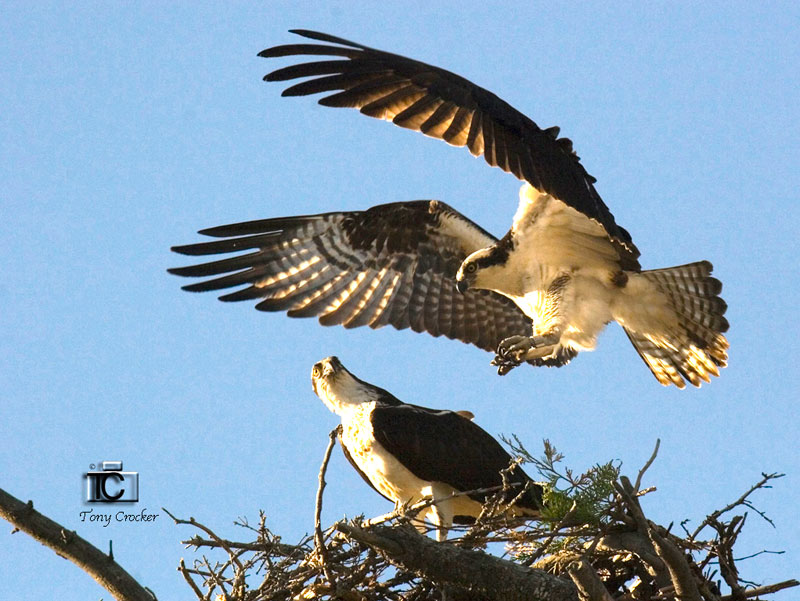Facts about Osprey
Did you know Canada supports one third of the world’s osprey population?

Osprey is a fish-eating hawk with a scientific name called pandion haliaetus. It is a spectacular big bird at the top of the aquatic food web. It has distinct characteristics such as:
- gull-like crook in the wing
- dark brown line through the eye and on the side of the face
- weighs 1.5 to 2.0 kg
- wingspan is 1.6 metres. Like other birds of prey the osprey has powerful sharp talons and a hooked beak for handling their prey.
The main predator of osprey eggs is the raccoon, while the great horned owl sometimes kill osprey chicks and adults.
Hunting Behavior
While young are on the nest, the male catches fish, eats the head, and brings the rest back to the female and young

Their hunting abilities are quite dramatic, as they are able to dive into the water from a height of up to 40 metres. The osprey has sharp spines on the soles of their feet that enable them to grasp their prey. When the osprey catches food their opposable outer toe is able to rotate to allow for better aerodynamics while in flight.
Male Osprey provide most of the food for the family while the mother remains at the nest for much of the summer. Osprey feed almost exclusively on fish. In the Great Lakes region their diet mainly consists of brown bullhead, rock bass, small- and largemouth bass, pumpkin seed, bluegill, white sucker, carp and yellow perch.
Nesting and Migrating behavior
The Pandionidae family has one species of osprey (yes, only one!), and this particular species of Osprey thrives in most parts of the world (well…except the Polar Regions). They breed commonly in most areas of Canada and the United States and these birds migrate up to 8000km to South and Central America.
Osprey breed in Canada between April and September. Their eggs are incubated for about 40 days. Chicks fledge in Mid-July when they are about 2 months old, however they remain close to the nesting site for another three weeks or so dependent on the parents for food.
Where Osprey live
Osprey live close to water bodies with a rich source of food and they are commonly found as scattered pairs in the interior of Canada and United States.
Osprey are adaptable birds and are able to nest in natural and artificial structures close to water including at the top of dead trees, hydro poles, duck blinds, microwave towers and navigation light towers respectively.
Osprey as Indicator of the Health of the Environment
Since osprey are at the top of the the aquatic food web they can be regarded as an indicator of the health and productivity of an ecosystem. If an area is polluted with certain chemicals, animals that are lower on the food chain may digest small amounts of that chemical. Animals such as the Osprey, are at the top of the food web, and will accumulate more toxins in their bodies, a term known as bio-accumulation, therefore, larger animals like Osprey, can effectively determine the condition of the natural environment they are living in.
An increase of organic chemical such as the PCBs and DDTs can lead to decline of Osprey population through egg shell thinning.

The Down and Up of Osprey Population
Osprey populations in the Great Lakes area began to decline in the 30’s and 40’s, however this decline did not become quite as evident as between the 60’s and 70’s, especially in the Great Lakes drainage basin. Osprey production was at its all time low producing on average 0.4 to 0.7 chicks per pair each year. In addition to this osprey eggs had significantly thinner shells than those collected before World War II.
The rapid decline of osprey production and the thinning of eggshells were directly related to the increase of chemicals in the Great Lakes region particularly through the watershed system. As government standards pertaining to the release and storage of industry wastes became more stringent, and the withdrawal of dichlorodiphenyltrichloroethane (DDT) use was evident, osprey-breeding populations in the Great Lakes region once again thrived. However, as levels of toxins decreased dramatically, PCB concentrations remained rather high especially in the Kawartha Lakes region.

The Lindsay-Peterborough area shows the highest concentrations of PCBs in the area to date. Past industrial activities in the Lindsay-Peterborough area have raised concern about the presence of PCBs above the analytical detection limits in the waterway. The historical use of PCBs by industry in the Kawartha Lakes region is quite evident. Over the long-term storm water discharge drained from these industrial sites would serve as the main reservoir for release of contaminants back into the watershed. Because high concentrations of PCBs are found in sediments many study components designed to assess the impacts of sediment contamination, as well as the potential effects of on-going sources is necessary to minimize the impact of PCBs in the environment.
The Ministry of Environment (MOE) as well as other government and interest groups have been monitoring PCB concentrations in the Lindsay-Peterborough area and have found many potential sources of PCB contamination. Unfortunately because sediment quality guidelines have been developed on a generic basis for application throughout the province, they are not suitable for determining the need for cleanup on a site-specific basis.
As the osprey becomes more common to the Great Lakes basin, more people become interested and fascinated with this awesome bird. Community and naturalists’ groups such as Friends of the Osprey have worked together with government agencies in various parts of the Great Lakes region to provide nesting platforms for osprey. These efforts are promoting the successful recovery of osprey populations, particularly in the areas where there seems to be a shortage of natural nest-sites. On the other hand the monitoring and control of toxins in the environment is an important issue that must not be ignored. It is quite evident that the release of PCBs and other toxins in the Kawartha Lakes region is affecting the health of the ecosystem and measures of control are necessary in order to ensure that the quality of the environment remains stable. And species such as the osprey at the top of the food web can tell us a great deal about the quality of the habitat in which it lives.
Follow Us:

